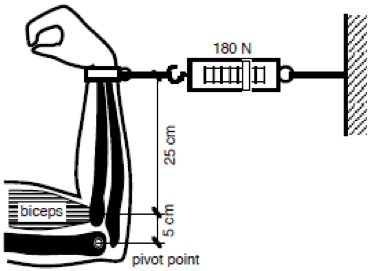Use the worked example above to help you solve this problem. A W =47.4 N (10.7 lb) weight is held in a person's hand with the forearmhorizontal, as shown in the figure. The biceps muscle is attached d= 0.03033 m from the joint, and the weight is l = 0.354 m from thejoint. Find the upward force vector F exerted by the biceps on theforearm (the ulna) and the downward force vector R exerted by thehumerus on the forearm, acting at the joint. Neglect the weight ofthe forearm.
F = N
F = lb
R = N
R = lb
EXERCISE HINTS: THIS IS WHAT I ACTUALLY NEED HELP WITH!
Use the values from PRACTICE IT to help you work this exercise.Suppose you wanted to limit the force acting on your joint to amaximum value of 8.21 102 N.
(a) Under these circumstances, what maximum weight would youattempt to lift?
Fmax = N
(b) What force would your biceps apply while lifting thisweight?
Fbiceps = N
Use the worked example above to help you solve this problem. A W =47.4 N (10.7 lb) weight is held in a person's hand with the forearmhorizontal, as shown in the figure. The biceps muscle is attached d= 0.03033 m from the joint, and the weight is l = 0.354 m from thejoint. Find the upward force vector F exerted by the biceps on theforearm (the ulna) and the downward force vector R exerted by thehumerus on the forearm, acting at the joint. Neglect the weight ofthe forearm.
F = N
F = lb
R = N
R = lb
EXERCISE HINTS: THIS IS WHAT I ACTUALLY NEED HELP WITH!
Use the values from PRACTICE IT to help you work this exercise.Suppose you wanted to limit the force acting on your joint to amaximum value of 8.21 102 N.
(a) Under these circumstances, what maximum weight would youattempt to lift?
Fmax = N
(b) What force would your biceps apply while lifting thisweight?
Fbiceps = N
